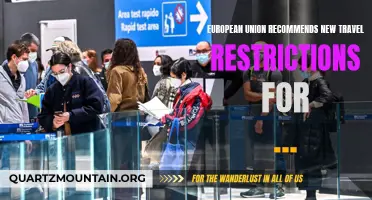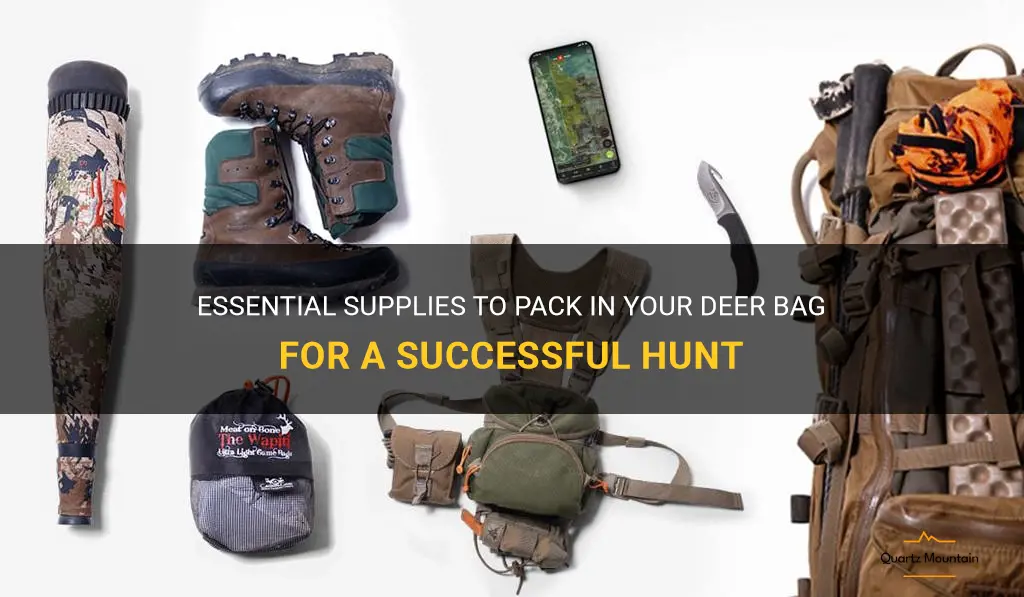
Are you an avid deer hunter looking to up your game and ensure a successful hunting trip? Look no further! In this article, we will explore the essential supplies you need to pack in your deer bag to make sure you have everything you need for a fruitful hunt. From gear and equipment to nourishment and safety, we've got you covered. So grab your bag and let's dive into the must-have items for your next hunting adventure!
| Characteristics | Values |
|---|---|
| Type of bag | Deer bag |
| Size | Various sizes available |
| Material | Breathable fabric |
| Durability | Strong and tear-resistant |
| Weight | Lightweight |
| Handles | Two handles for easy carrying |
| Closure | Zipper or drawstring closure |
| Color | Usually comes in orange or camo |
| Scent control | Some bags have scent control features |
| Waterproof | Some bags are waterproof or water-resistant |
| Pockets | Some bags have exterior pockets for accessories |
| Ventilation | Mesh panels or vents for air circulation |
| Cleaning | Machine washable or easy to clean |
| Packability | Folds or rolls up for easy storage |
| Price | Range varies based on brand and features |
What You'll Learn
- What essential items should be included in a deer bag for hunting?
- How do you determine the appropriate size and type of deer bag to pack?
- Are there any specific regulations or guidelines regarding the contents of a deer bag?
- What steps should be taken to ensure proper storage and preservation of game in a deer bag?
- Are there any additional items or tools that may be useful to have in a deer bag?

What essential items should be included in a deer bag for hunting?
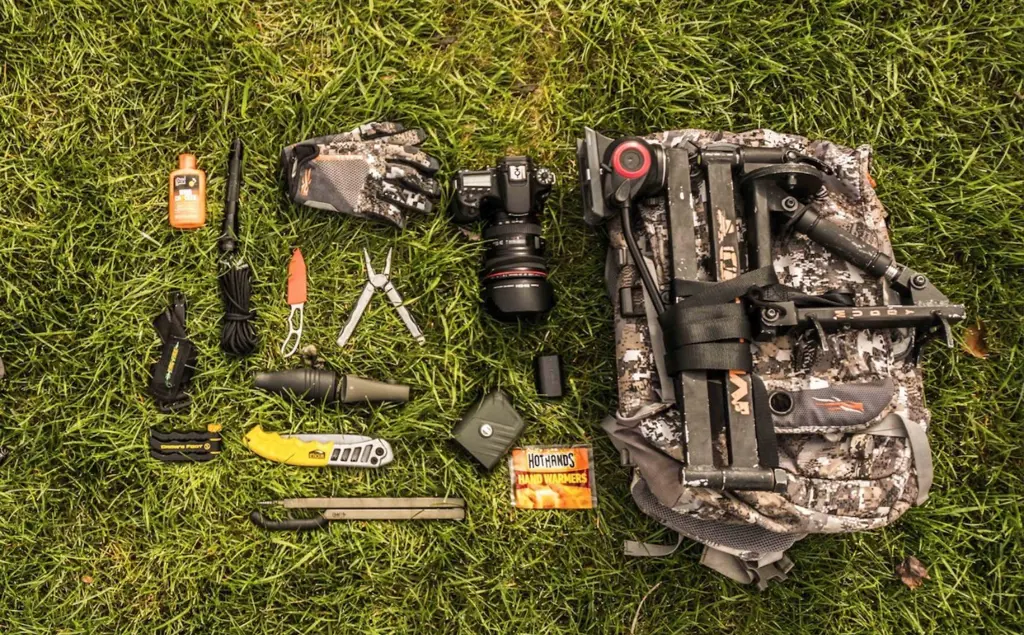
A deer bag, also known as a field dressing kit or game bag, is an essential piece of equipment for hunters. It contains all the necessary items to field dress and process a deer after a successful hunt. Having a well-equipped deer bag ensures that the meat is properly handled and preserved for consumption. In this article, we will discuss the essential items that should be included in a deer bag for hunting.
- Gloves: The first item in a deer bag should always be a pair of gloves. Gloves serve two purposes – they protect the hunter's hands from dirt, blood, and bacteria, and they prevent any contamination of the deer meat. Disposable gloves are convenient, as they can be easily discarded after use.
- Hunting Knife: A sharp hunting knife is a crucial tool for field dressing and processing a deer. It should have a strong and durable blade for cutting through tough hide and bones. A knife with a gut hook is especially useful for opening up the deer's abdomen.
- Bone Saw: A bone saw is necessary for cutting through the deer's pelvic bone and ribs. This allows for better access to the internal organs, making the field dressing process easier.
- Field Dressing Tools: Field dressing tools include items such as a gutting tool or a gut hook, which are used to remove the deer's internal organs. These tools help make the process quicker and cleaner.
- Game Bags: Game bags are used to store and transport the field-dressed deer. They help to protect the meat from dirt, insects, and other contaminants. Nylon or breathable fabric game bags are ideal for preserving the quality of the meat.
- Zip Ties or Rope: Zip ties or rope are essential for tying the deer's legs together after field dressing. This ensures that the deer remains stable and can be easily transported.
- Plastic Bags: Plastic bags are useful for storing the deer's heart, liver, and other edible organs separately from the meat. Some hunters also use plastic bags to transport the field-dressed deer, especially if they need to be carried over a long distance.
- Game Tag: A game tag is required in most hunting jurisdictions to legally identify and validate the harvested animal. It should be securely attached to the deer's ear or antler to comply with legal requirements.
- Game Shears: Game shears are useful for cutting through bones and joints when separating the joints of the deer's legs. They make it easier to remove the legs for transportation or further processing.
- Knife Sharpener: A knife sharpener is essential for maintaining the sharpness of the hunting knife. Field dressing and processing a deer can put a lot of strain on the knife, and a sharp blade makes the task easier and safer.
In conclusion, a well-equipped deer bag is essential for every deer hunter. It should contain gloves, a hunting knife, a bone saw, field dressing tools, game bags, zip ties or rope, plastic bags, a game tag, game shears, and a knife sharpener. With these essential items in your deer bag, you will be prepared to field dress and process a deer after a successful hunt. Remember to follow all local regulations and ethical practices when handling and processing game.
The Essential Packing Guide for a 3-Night Trip to Spain
You may want to see also

How do you determine the appropriate size and type of deer bag to pack?
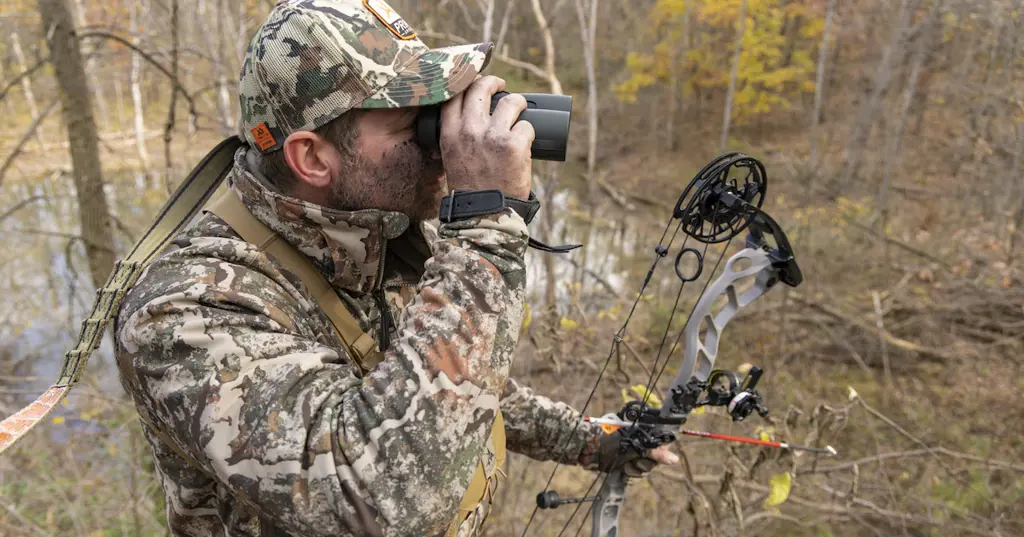
When it comes to deer hunting, one of the most important aspects is determining the appropriate size and type of deer bag to pack. The right bag will not only ensure that your deer is transported safely, but also keep it fresh until you reach your destination. In this article, we will discuss how to determine the appropriate size and type of deer bag to pack.
There are a few factors to consider when choosing the size of your deer bag. Firstly, you need to consider the size of the deer you plan on hunting. Larger deer will require a bigger bag to accommodate their size, while smaller deer may fit comfortably in a smaller bag. Secondly, you need to take into account the number of deer you plan on hunting. If you are hunting in a group and anticipate taking down multiple deer, you will need a bag that can hold all the carcasses without overcrowding or damaging them.
In addition to size, you also need to consider the type of deer bag that will best suit your needs. There are several options available, including nylon meat bags, game bags, and plastic bags. Nylon meat bags are a popular choice as they allow the deer to breathe while keeping insects and dirt out. Game bags, on the other hand, are specifically designed for hunting and have a tighter weave to prevent flies from reaching the meat. Finally, plastic bags can be used as a last resort if you cannot find a meat or game bag. However, it is important to note that plastic bags do not allow the deer to breathe and can cause the meat to spoil more quickly.
To determine the appropriate size and type of deer bag to pack, follow these step-by-step instructions:
- Assess the size of the deer you plan on hunting. This will help you determine the appropriate size of the bag.
- Determine how many deer you plan on hunting. This will help you determine the number of bags you will need.
- Research the different types of deer bags available and consider their pros and cons.
- Choose the type of bag that best suits your needs and preferences.
- Purchase the appropriate size and type of bag based on your assessment and research.
For example, let's say you are planning to hunt a large deer and anticipate taking down two more deer. After researching the available options, you decide to purchase a set of nylon meat bags that are specifically designed for larger game. This way, you can ensure that the deer will be properly protected and kept fresh during transportation.
In conclusion, determining the appropriate size and type of deer bag to pack is crucial for a successful hunting trip. By considering factors such as the size of the deer and the number of deer you plan on hunting, as well as researching the available options, you can make an informed decision. Remember, the right bag will not only ensure the safe transportation of your deer but also keep the meat fresh for consumption.
Essential Items to Pack in Your Backpack for a Memorable Visit to Disney World
You may want to see also

Are there any specific regulations or guidelines regarding the contents of a deer bag?
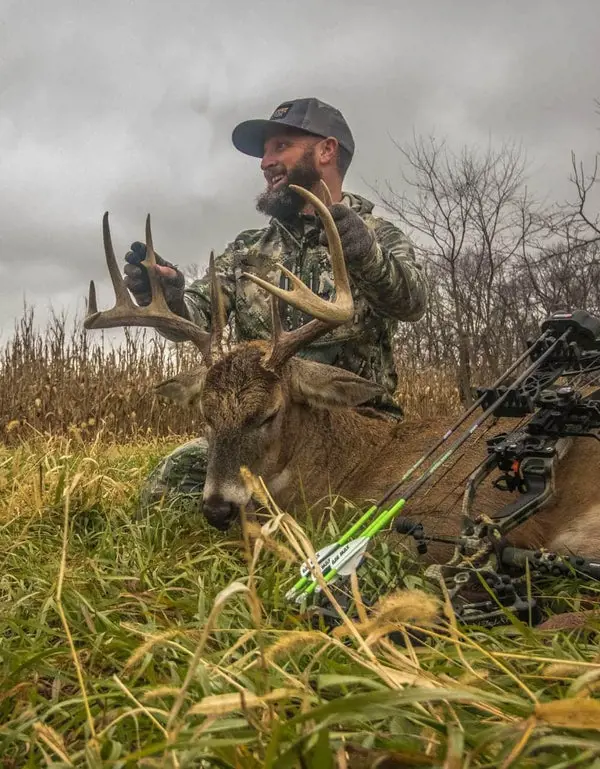
When it comes to hunting deer, there are certain regulations and guidelines that hunters must follow, including those related to the contents of a deer bag. A deer bag is a bag or container that hunters use to transport the harvested deer from the field.
One of the most important guidelines regarding the contents of a deer bag is the requirement to properly tag the deer. In most regions, hunters are required to attach a tag to the deer stating the hunter's name, hunting license number, and the date and time of the kill. This helps to ensure that hunters are complying with hunting laws and regulations, and also provides important information for wildlife management purposes.
In addition to tagging the deer, it is also important to properly handle and store the meat to ensure its quality and safety. After harvesting a deer, it is important to field dress the animal as quickly as possible. Field dressing involves removing the internal organs, such as the heart, liver, and intestines, from the deer. This helps to cool the carcass and prevent bacterial growth, which can spoil the meat. It is important to handle the meat with clean hands and to remove any hair, dirt, or debris that may be on the carcass.
Once the deer has been properly field dressed, it is important to transport it in a clean and sanitary manner. This means using a clean deer bag or container to avoid the risk of contamination. It is also important to keep the meat cool during transport to prevent spoilage. This can be done by keeping the deer bag in a cooler or by using ice packs or frozen water bottles to keep the meat cool.
It is also worth noting that there may be specific regulations or guidelines regarding the transportation of deer from one region to another. Some regions may require hunters to obtain a transportation permit or to follow specific procedures when transporting a deer across state or provincial lines. It is important for hunters to familiarize themselves with the regulations and guidelines in their specific region to ensure compliance.
In conclusion, there are specific regulations and guidelines that hunters must follow regarding the contents of a deer bag. These include properly tagging the deer, field dressing the animal, and transporting the meat in a clean and sanitary manner. By following these guidelines, hunters can ensure the quality and safety of the meat and comply with hunting laws and regulations.
Essential Items to Pack for an Infant on a Cruise
You may want to see also

What steps should be taken to ensure proper storage and preservation of game in a deer bag?
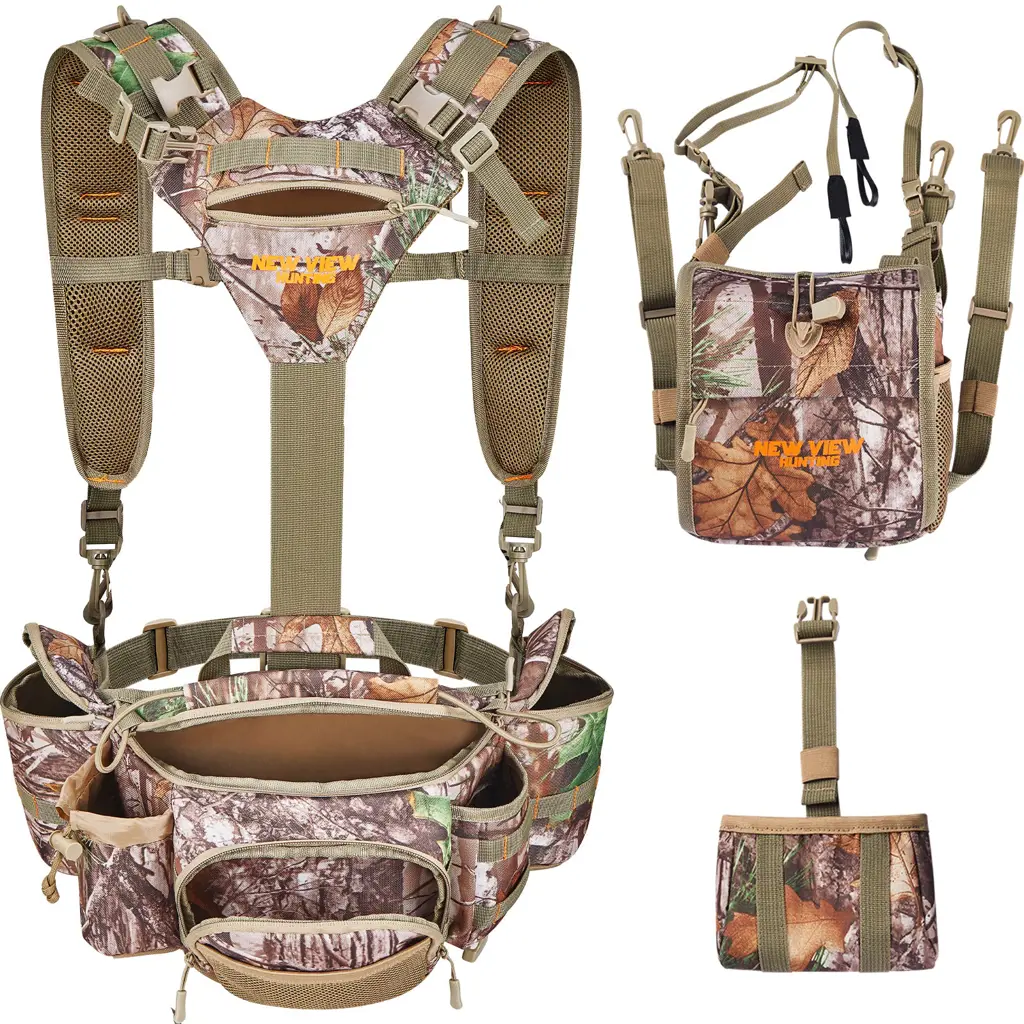
When it comes to hunting and game management, proper storage and preservation of game is essential. This is particularly true when using a deer bag to transport and store harvested deer. Whether you are a seasoned hunter or a novice, following these steps will help ensure the quality and freshness of the meat.
Step 1: Field Dressing
The first step in proper storage and preservation begins immediately after the deer is harvested. Field dressing the deer involves removing the internal organs to prevent spoilage and contamination. This should be done as soon as possible to minimize the risk of bacterial growth and to help cool down the carcass.
Step 2: Cooling the Carcass
After field dressing, it is critical to cool the carcass as quickly as possible. One effective method is to hang the deer in a cool, shaded area with good air circulation. Avoid direct exposure to sunlight or warm temperatures, as this will accelerate spoilage. If the weather is warm or if you are unable to hang the deer, consider placing ice packs or bags of ice inside the body cavity to help maintain a cool temperature.
Step 3: Thoroughly Clean the Deer Bag
Before placing the deer in the bag, it is crucial to clean and sanitize it thoroughly. Use hot water and a mild detergent to remove any dirt or debris. Rinse it thoroughly and then use a sanitizing solution such as a mixture of bleach and water to ensure it is free from bacteria. Be sure to allow the bag to dry completely before use.
Step 4: Properly Secure the Deer in the Bag
When placing the deer in the bag, make sure it is properly secured to prevent any spoilage or contamination. If the deer is small enough, you may be able to fit it whole in the bag. However, if it is too large, it may need to be quartered or deboned before placing it in the bag. Make sure to remove any excess fat or connective tissue, as this can contribute to spoilage.
Step 5: Store in a Cool Environment
Once the deer is properly secured in the bag, it should be stored in a cool environment such as a walk-in cooler or refrigerator. Ideally, the temperature should be between 34-40 degrees Fahrenheit. If you do not have access to a cooler, consider using a cooler filled with ice or storing the deer in a shady area with good air circulation. Avoid storing the deer in areas with fluctuating temperatures or where it may be exposed to direct sunlight.
Step 6: Regularly Monitor and Rotate Carcasses
To ensure the freshness of the meat, it is important to regularly monitor and rotate the carcasses. Check the temperature of the storage area regularly and adjust as needed. Additionally, periodically inspect the deer for any signs of spoilage such as an off odor or slimy texture. If you notice any signs of spoilage, it is best to discard the meat to avoid the risk of foodborne illness.
Proper storage and preservation of game in a deer bag are critical to ensure the quality and safety of the meat. By following these steps, you can enjoy fresh, delicious game meat for months to come. Remember, always prioritize food safety and follow local regulations when handling and storing game.
Essential Packing List for Visiting Northern Italy in April
You may want to see also

Are there any additional items or tools that may be useful to have in a deer bag?
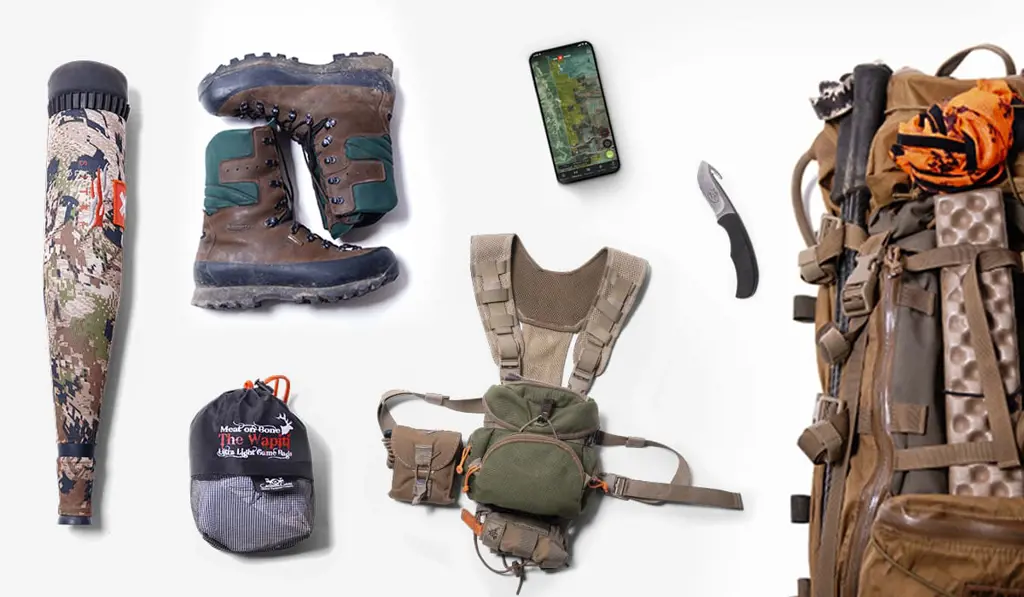
When it comes to deer hunting, having the right gear and equipment is essential. While a deer bag is primarily used to carry and transport the harvested deer, there are a few additional items and tools that can be useful to have in the bag. These items can help make the hunting experience more efficient and safe.
One of the most important additional items to have in a deer bag is a field dressing kit. This kit typically includes a sharp knife, gloves, and other tools that are necessary for field dressing the deer. Field dressing is the process of removing the internal organs and preparing the deer for transport. Having a field dressing kit in the bag ensures that you have all the necessary tools to properly process the deer in the field.
Another useful item to have in a deer bag is a rope or drag line. After the deer has been field dressed, it needs to be transported back to the vehicle or camp. Having a rope or drag line can make this process much easier. By attaching the rope to the deer's antlers or legs, you can easily drag it through the woods without straining your back.
A small first aid kit is also a good idea to have in a deer bag. Accidents can happen while hunting, and having basic first aid supplies can help treat minor injuries. It is important to have bandages, antiseptic wipes, and other essentials in case of any cuts or scrapes while in the field.
In addition to these items, it is also helpful to have a water bottle or hydration pack in the deer bag. Hunting can be physically demanding, and staying hydrated is crucial for both safety and performance. Having a water source readily available in the bag ensures that you can replenish your fluids while out in the field.
Lastly, a small survival kit can be a valuable addition to the deer bag. This kit should include basic survival items such as matches, a compass, a whistle, and a small flashlight. While it is unlikely that you will get lost during a deer hunt, having these items can provide peace of mind and be helpful in emergency situations.
In conclusion, while a deer bag is primarily used for carrying the harvested deer, there are several additional items that can be useful to have in the bag. A field dressing kit, rope or drag line, first aid kit, water bottle, and survival kit are all important tools that can make the hunting experience more efficient and safe. By being prepared with the right gear, hunters can ensure a successful and enjoyable deer hunting trip.
Essential Items to Pack for a Water Polo Tournament
You may want to see also
Frequently asked questions
When packing your deer bag, it is important to include essential items such as field dressing tools, gloves, rope or drag line, a hunting knife, a tarp or game bag, and zip ties. These items will help you effectively field dress and transport your deer.
While you don't necessarily need specialized equipment, having a good quality hunting knife is essential for field dressing a deer. Look for a knife with a strong, sharp blade that is easy to handle. Additionally, some hunters prefer to use gut hooks or saws to assist in the field dressing process.
It is always a good idea to pack some extra items in your deer bag. These can include things like hand warmers, water bottles, snacks, a small first aid kit, a flashlight, and extra batteries. Having these additional items on hand can help make your hunting trip more comfortable and prepared for unexpected situations.






